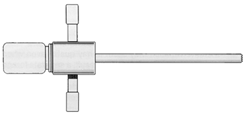Sampling alfalfa using a probe is preferred over hand
sampling since it is faster and a better sample is obtained. Because probe type does not
significantly affect sampling accuracy, producers should look at the cost and their
individual preference when determining the type to use. Following are some descriptions of
several probe types.

Forageurs Hay Probe: This probe can be ordered from Forageurs Corp., 20788 Holyoke Avenue
W., Lakeville, MN 55044 (Phone: 612-469-2596). It is made of stainless steel with a
resharpenable hardened-steel tip. The probe has a canister attached where up to 25 cores
can be collected as bales are sampled. Both 14" and 24" tubes are available that
cut cores 0.6" in diameter. The probe is designed for use with a hand brace but can
be used at slow speeds with an electric drill.

Hay Chec Sampler: This probe can be ordered from Hodge Products Inc., P.O. Box 1326, El
Cajon, CA 92022 (Phone: 619-444-3147). It is made of stainless steel with a resharpenable
serrated, hardened-steel tip. The tube is 12" long and cuts a core 0.44" in
diameter. The unit has a large body with handles for pushing the sampler into a bale by
hand rather than drilling. A canister is attached where cores are collected as bales are
sampled. No extensions are available for the unit.

Oakfield Probe: This probe can be ordered from Oakfield Apparatus Inc., P.O. Box 65,
Oakfield, WI 53065 (Phone: 414-583-4114). It is made of stainless steel with a replaceable
serrated screw-on tip. The tube is 18" long and cuts a core 0.75" in diameter.
Cores are removed from an open area on the side of the tube between samples. The probe is
available for use with an electric drill or hand brace. Extension adapters are available
for deeper sampling.

Penn State Forage Sampler: This probe can be ordered from Nasco, 901 Janesville Avenue,
P.O. Box 901, Fort Atkinson, WI 53538-0901 (Phone: 414-563-2446). It is made of stainless
steel with a replaceable hardened-steel cutting tip. The tube is 18" long and cuts a
core 0.75" in diameter. The probe is available for use with an electric drill or hand
brace and must be disassembled and emptied between each core. Extension adapters are
available for deeper sampling.

Utah Hay Sampler: This probe is made of steel with a
resharpenable, serrated, hardened-steel tip. The tube is 15" long and cuts a core
0.5" in diameter. External threads on the tube help pull the sampler into the bale. A
canister is attached where up to 20 cores can be collected as bales are
sampled. Current supplier is unknown.
Homemade Probes: Forage probes can be made at home to avoid
the expense of purchasing commercially available types. Research has shown that homemade
probes work just as well as commercial probes when proper sampling techniques are used.
One way of making a homemade probe is to cut-off the ends of a golf club leaving a shaft
at least 15" long and 0.4" in diameter. A plastic bag can be attached to the
larger end with a rubber band, and the shaft driven into a bale for sampling. This type of
homemade probe is effective for sampling compact bales. For more loosely packed hay,
farmers often build homemade probes with 1-2" diameter tubes. The larger diameter
reduces problems with sifting of the probe through the hay and increases sampling speed.
These types of homemade probes often mimic commercial probes in that they are used with an
electric drill or hand brace.
For additional information:
Forage Quality Interpretations. OSU
Extension Facts F-2117
Hay Judging. OSU
Extension Facts F-2588
Collecting Forage Samples for Analysis. OSU
Extension Facts F-2589
See the following website for other hay sampling
equipment:
http://agronomy.ucdavis.edu/alfalfa.wg/SUBPAGES/ForageQuality/ListofHayProbes.htm
Minimizing
Losses in Hay Storage and Feeding
Understanding
Forage Quality
|


